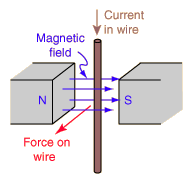Electromagnetic Induction
Introduction
Ørsted had discovered that electricity and magnetism were linked, electric current gave rise to magnetic fields. However no one had succeded in generating electricity by using magnetic fields, until Michael Faraday found that moving a conductor in a magnetic field (or by moving the magnet field near a stationary conductor) created a voltage. The wire must be part of an electrical circuit. Otherwise the electrons have no place to go. In other words, there is no electrical current produced with a wire with open ends. But if the ends are attached to a light bulb, to an electrical meter or even to each other, the circuit is complete and electrical current is created.

Direction of Current
The direction of the current is determined by Flemming's Right hand rule. The left-hand rule is used for motors and motion produced by a magnetic field. The right-hand rule is used for generators and current generated by a motion. Using the right-hand, the thumb is in the direction of the motion, the first finger points in the direction of the field and the second finger points in the direction of the current.
Flux and Flux Linkage
To create electricity all that was required was a coil of wire, ends of which may be connected to a voltmeter. The voltage created depends on the density of the magnetic field and the area of the loop cutting the magnetic field lines.
A quantity called the flux measures this and is give by &phi = BA where B is the magnetic flux density and A is the area of the coil in the magnetic field.
If there are more turns in the coil then the flux is termed the magnetic flux linkage. It is given by Nφ =BAN. This assumes that the loop cuts the magnetic field lines at an angle of 90°. If the loop cuts the magnetic field lines at a different angle say, θ then the flux linkage is defined as N&phi = BANcos θ where theta is the angle by the normal to the area and the magnetic field lines as shown in Figure 1.
Faraday's Law of Induction
We said that a voltage or Electro-Motive Force (EMF), is produced when the loop is moved in the magnetic field but more qualitatively, the voltage is produced is in responce to the change in the motion. The voltage produced depends on the rate of change of flux-linkage with time. In mathematical terms,

where E is the EMF. The other symbols have their usual meanings. The minus sign is a consequence of Lenz's Law which we shall discuss in the following section.
Lenz's Law
When we move a conductor in a magnetic field the current generated creates it's own magnetic field. If the magnetic field created had an additive effect to the original magnetic field then the magnetic field would become even stronger and this would create an even stronger current which would create an even strong magnetic field, and so on. If this were to happen we could get energy for free although the universe might explode. Unfortunately we cannot make free energy the reason is down to the Lenz's law. When a current is generated, the magnetic field produced by the current is in opposition to the original magnetic field. This produces a force opposes the motion of the conductor and brings it to a halt. This is why it becomes more difficult to turn a dynamo on a bicycle as you increase in speed. We express Lenz's law in as part of Faraday's Law by inserting a minus sign.
